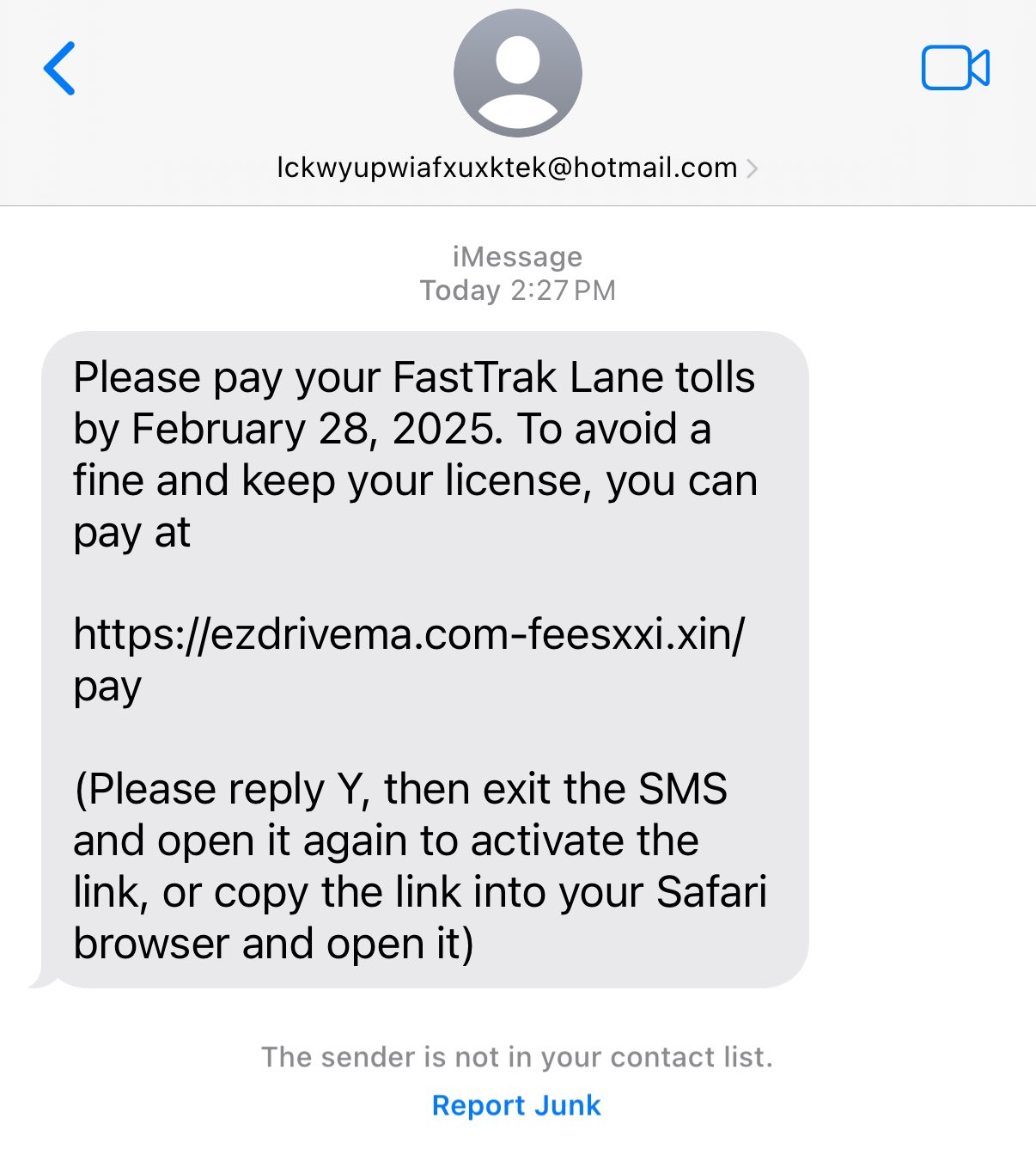Beware of Toll Road Text Scams: Protect Yourself from Fraudulent Charges

Lately, scammers have been targeting drivers with deceptive messages about unpaid tolls, a tactic known as “smishing.” These fraudulent texts often claim you owe money for tolls and urge immediate payment to avoid penalties. They typically include a link that, when clicked, leads to a phishing site designed to steal your personal and financial information.
How the Scam Works:
- Deceptive Messages: You receive an unsolicited text stating you have unpaid tolls, sometimes specifying an amount owed and threatening late fees.
- Phishing Links: The message includes a link directing you to a fake website resembling an official toll agency’s site, prompting you to enter sensitive information.

Recent Incidents:
Texas: The Texas Department of Transportation (TxDOT) warned about fraudulent texts targeting toll users, emphasizing that legitimate communications do not come via text messages.
Bay Area, California: A surge in FasTrak scams has been reported, with fake texts demanding toll payments and threatening penalties. Authorities advise against clicking on suspicious links, as FasTrak does not communicate via text message.
Protective Measures:
- Avoid Clicking Links: Do not click on links in unsolicited texts.
- Verify with Official Sources: Contact the tolling agency directly using known contact information to confirm any claims.
- Report Suspicious Messages: Use your phone’s “report junk” option or forward the message to 7726 (SPAM).
- Monitor Accounts: Regularly check your toll accounts for unauthorized charges.
Watch Out! The USPS Text Scam is Back (and Sneakier Than Ever)

We all rely on the USPS to deliver our mail and packages, but scammers are exploiting that trust with a devious new trick: the USPS text scam, also known as “smishing.” This isn’t just another annoying robocall; it’s a carefully crafted attempt to steal your personal information and leave you vulnerable to identity theft.

How the Scam Works:
Imagine this: You receive a text message that appears to be from the United States Postal Service. It might say something like:
- “Your package delivery has been delayed due to an unpaid shipping fee. Click here to resolve.”
- “We were unable to deliver your package. Please call this number to reschedule.”
- “Your package is being held at our facility. Verify your address to avoid return to sender.”
These messages often use urgent language to create a sense of panic. They want you to act quickly without thinking. The key element is a link or a phone number. Clicking the link takes you to a fake website that looks convincingly like the real USPS site, where you’re asked to enter sensitive information. Calling the number connects you to a scammer posing as a USPS representative.

The Danger Lurking Behind the Link:
The goal of these scams is simple: to trick you into handing over your personal and financial data. This could include:
- Account usernames and passwords
- Social Security numbers
- Dates of birth
- Credit and debit card numbers
With this information, scammers can wreak havoc on your finances and your identity.
How to Protect Yourself:
The good news is, you can easily protect yourself by remembering these crucial points:
- USPS Doesn’t Initiate Contact via Text or Email (Unless You Specifically Request It): The USPS will not send you unsolicited text messages or emails. The only exception is if you’ve signed up for tracking updates using a specific tracking number.
- USPS Messages Never Contain Links: Legitimate USPS communications will never include clickable links. This is a huge red flag.
- Be Wary of Urgent Language: Scammers use urgency to pressure you. Take a moment to think before you act.
What to Do If You Receive a Suspicious Text:
- DO NOT click on any links.
- DO NOT call any numbers provided in the text.
- Delete the message immediately.
- Report the scam: You can report the message to the USPS Inspection Service (www.uspis.gov) or the Federal Trade Commission (FTC) at ReportFraud.ftc.gov.
Stay Vigilant, Stay Safe:
By staying informed and following these simple tips, you can protect yourself from the latest USPS text scam and avoid becoming a victim of identity theft. Don’t let scammers ruin your day – be smart and stay safe!
